Author Archives: Phyl Terry
Art and Dresses – Slow Art Day Summer 2022 Retreat
We began our nine-day 2022 Slow Art Day volunteer team retreat by visiting the site of the first test of Slow Art Day: MoMA in New York.
In 2009, Phyl organized four people to visit MoMA and look slowly at five artworks. 13 years and thousands of events later, they returned again with a group of four, but this time it was the dedicated Slow Art Day volunteer team with dresses to match the art.
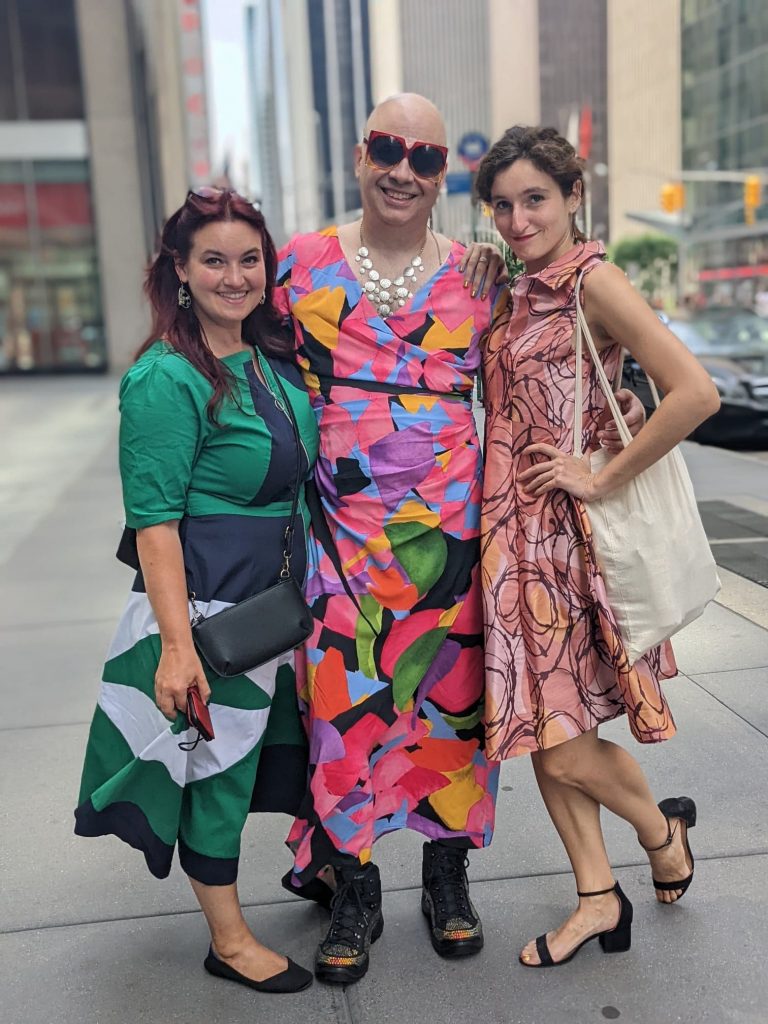
While looking slowly together in various museums, we decided to use our slow looking algorithm that can be used by small groups anytime all over the world.
Phyl first tried this in 2012 when they took three young brothers to their first art museum with a mother sure they would bounce off the walls and not look — she was shocked when they all slowed down and spent time with the art.
Here’s how it works:
- Assign a “selector” in each gallery
Choose someone who will select an artwork to look at slowly. - Then everyone looks around for a few minutes
While that’s happening, the selector picks their piece. - Look slowly at the chosen piece
Spend 5 – 10 minutes looking together at the artwork. - Talk about it
Ask: what did you see? Then don’t try to moderate. People will have a lot to say. Let them say it. In fact, this is a wonderful moment. You will get closer to each other as you learn how each other sees and thinks. - Move to the next gallery, choose the next selector, and repeat
That’s it. Really simple. Nothing else required.
Further, if you do this as a group – and if you are dressed up like we were – then you’ll likely draw a crowd whenever you slow down to look at a piece of art intensively. That’s certainly what happened to us. No matter what we looked at, it became a temporary “Starry Night” or “Mona Lisa” with big crowds assembling to figure out why everyone is looking (note: this is a great way to get visitors to pay more attention to less well-known art).
At MoMA, Johanna was the selector for the first gallery we visited. She skipped “Starry Night” and chose Edvard Munch’s “The Storm” (1893). Everyone knows Munch’s “The Scream.” Fewer know “The Storm” and we were glad to bring more attention to this terrific painting.
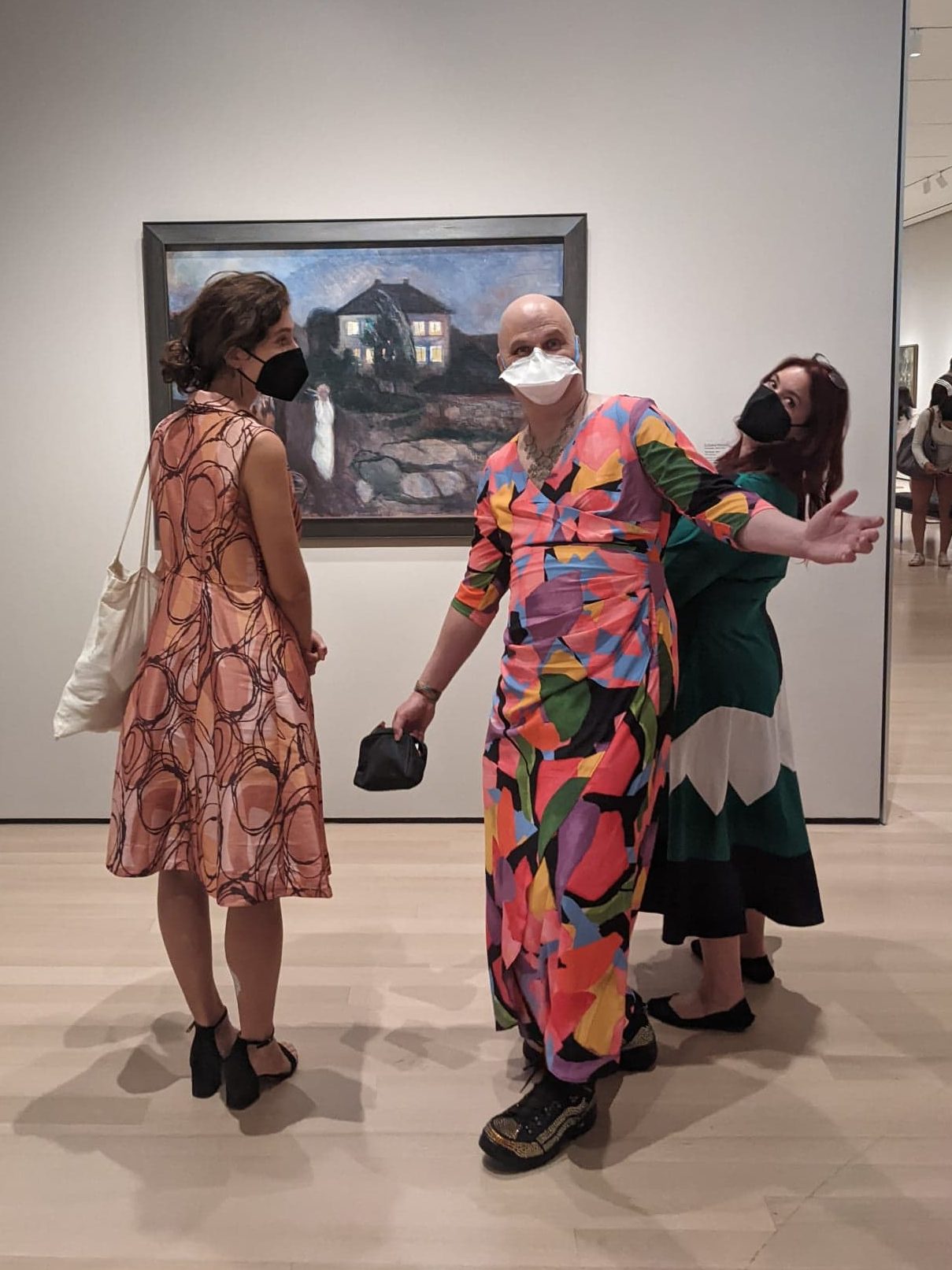
In our discussion after the slow look, we of course learned more about this artwork and more about each other. Johanna and Jessica Jane are very good close lookers. Meanwhile, Phyl is most sensitive to color, while Ashley’s eye for design picks up composition and texture.
We finished this first session feeling more connected to each other, and to the art.
We then moved to the next gallery, where Jessica Jane was the selector. And so it went as we slowly looked our way through MoMA, the Met, the Whitney, The Barnes Foundation (in Philadelphia), the Philadelphia Museum of Art, and Philadelphia’s Magic Gardens.
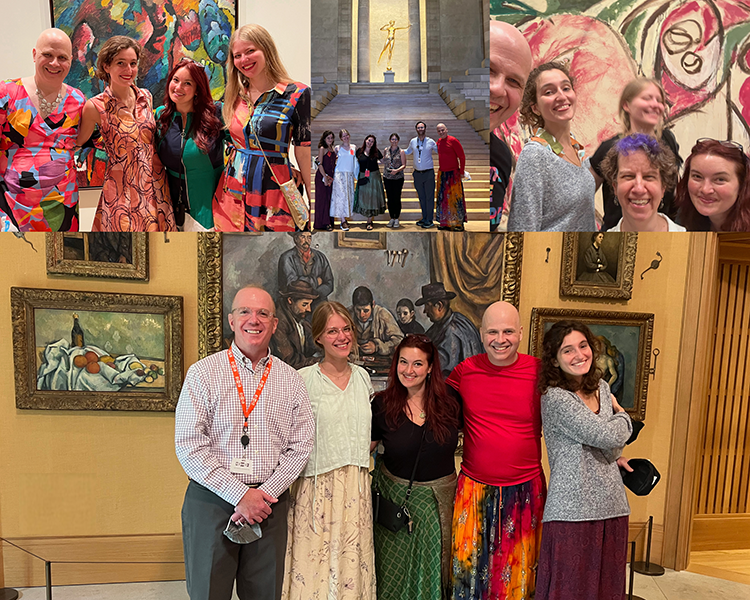
Special thanks to the educators who hosted us along the way, including:
- Bill Perthes, Director of Adult Education at The Barnes Foundation
- Linnea West, Manager of Adult Public Programs, Philadelphia Museum of Art
- Greg Stuart, Coordinator of Adult Public Programs, Philadelphia Museum of Art
- Lisa Dombrow, play activist, educator, and volunteer at MoMA and AMNH (and original ‘slow looker’)
We can’t wait for our Summer 2023 Slow Art Day retreat somewhere in the world (if you want us to come visit you and your institution, then let us know!).
– Phyl, Ashley, Jessica Jane, and Johanna
Retreat with the Global Slow Art Day Team
We just finished our first ever Slow Art Day team retreat with founder Phyl Terry (U.S.) and global team members Ashley Moran (U.S.), Jessica Jane Nocella (Italy), and Johanna Bokedal (Norway). We came together in New York and Philadelphia for nine days of slow art, friendship, and fun.
We will be posting several reports highlighting our time together at:
- MoMA (New York)
- The Met (New York)
- The Whitney (New York)
- The Barnes Foundation (Philadelphia)
- The Philadelphia Museum of Art
- Philadelphia’s Magic Gardens
Like happens all over the world with Slow Art Day, looking slowly deepened our ability to see from multiple perspectives, to love art even more, and to create closer bonds of friendship and community with each other.
In the reports that follow, we’ll share what we saw, what we learned, and the simple slow looking algorithm we used at each venue.
Highlights include our coordinated dresses at MoMA, our long conversation and slow looking with the Director of Education at the Barnes Foundation (and a very interesting idea he floated), and our time with the team at the Philadelphia Museum of Art.
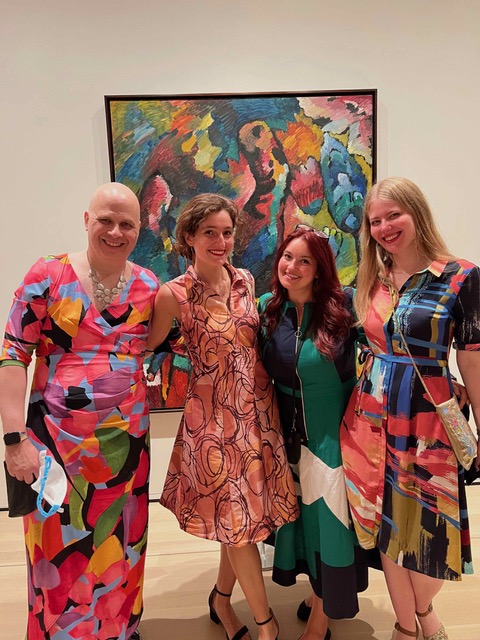
We are sad to end our retreat.
The good news, though, is we are looking forward to visiting other participating Slow Art Day institutions in future years around the world.
And, we are even beginning to put together a global Slow Art conference in 2025 in partnership with a great art museum (more on that in the next several months).
With much love,
Phyl, Ashley, Jessica Jane, and Johanna
P.S. Our longtime global coordinator Maggie Freeman, who is studying for a PhD in Islamic Art & Architecture at MIT, could not join us for this one, but we look forward to future summer retreats with her.
Slowing Down for Summer
Enuma Okoro, weekly columnist for the Financial Times, wrote a lovely article this week, The joy of living off the clock (gift link – first 20 readers to click will have access), about slowing down for summer and some of the art that reflects that.
In the column, Okoro spends time with three paintings: Khari Turner’s, “Get Home Before Dark“; John Singer Sargent’s “Two Girls Fishing“, and Njdeka Akunyili Crosby’s “Remain, Thriving.”
In looking slowly at these paintings, Okoro combines her life experience, her work as a curator, her knowledge of art history, and her good eye.
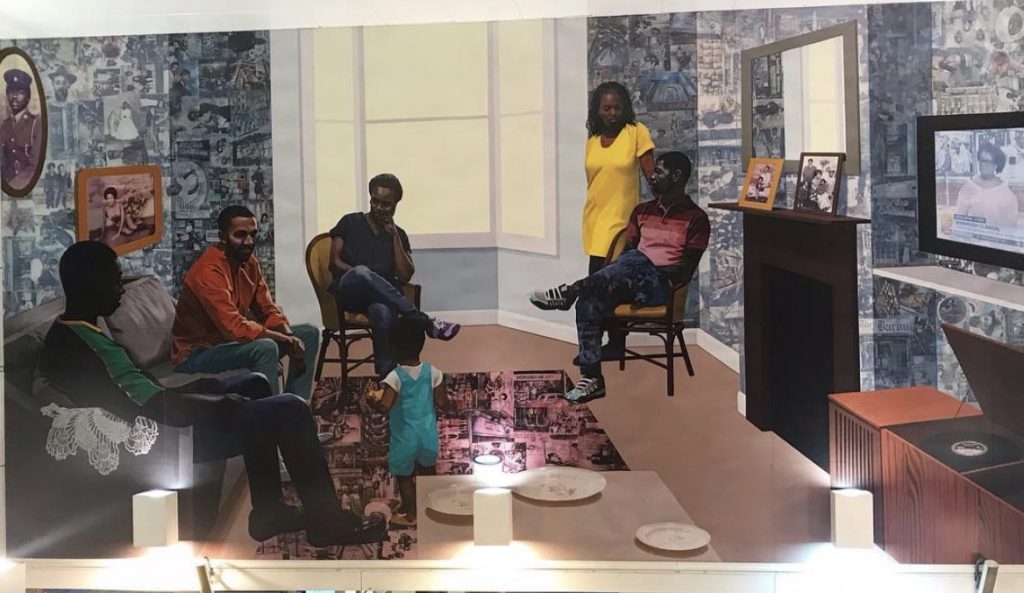
Enjoy her article.
Meanwhile, the Slow Art Day volunteer team is beginning the process of writing up the reports from this year’s event. We will begin publishing soon and through the autumn. Be patient with us as we slowly work our way through all of your great work.
Hope you are having a good and slow May.
Phyl
P.S. The Slow Art Day HQ team will be slowing down this summer *together*! For the first time, we’ll meet in person (we work via Zoom across continents) and slowly look at art in New York and Philadelphia. We’ll share more about our plans soon in case you want to join us.
Special Message from Kyiv’s Slow Art Day
Hope you had a wonderful Slow Art Day 2022. We look forward to all of your post-event updates, which we will begin turning into written reports (and publish here throughout the year and then in our annual report at the end of 2022).
But today, on the day after Slow Art Day, I want to share this (lightly edited) message we received from Kyiv and the Khanenko Museum just before this year’s event.
I am Hanna Rudyk, a Deputy Director of Education and Communication at the Khanenko Museum in Kyiv, Ukraine.
The Khanenko Museum (officially: the Bohdan and Varvara Khanenko Nationam Museum of Arts), which holds the largest Ukrainian collection of art from around the world, has been a Slow Art Day host for the last three years.
This year we were also planning to host the event in our museum. But Russia’s war against Ukraine prevented us from going forward with these plans. So, we decided instead to switch our Slow Art Day to an online event focused on one artwork. We will show a very rarely exhibited piece of Chinese art and ask our followers to contemplate upon it and share ideas. In the afternoon, we will give time for our curator to add some comments.
I wonder, if our plans could be somehow reflected on the Slow Art Day Official website. We are truly committed to the ideas underlying Slow Art Day and we urgently need now to be more visible and supported.
Below is the artwork they looked at yesterday and the MS Word file they sent last night with the online prompts and some of the comments they received.
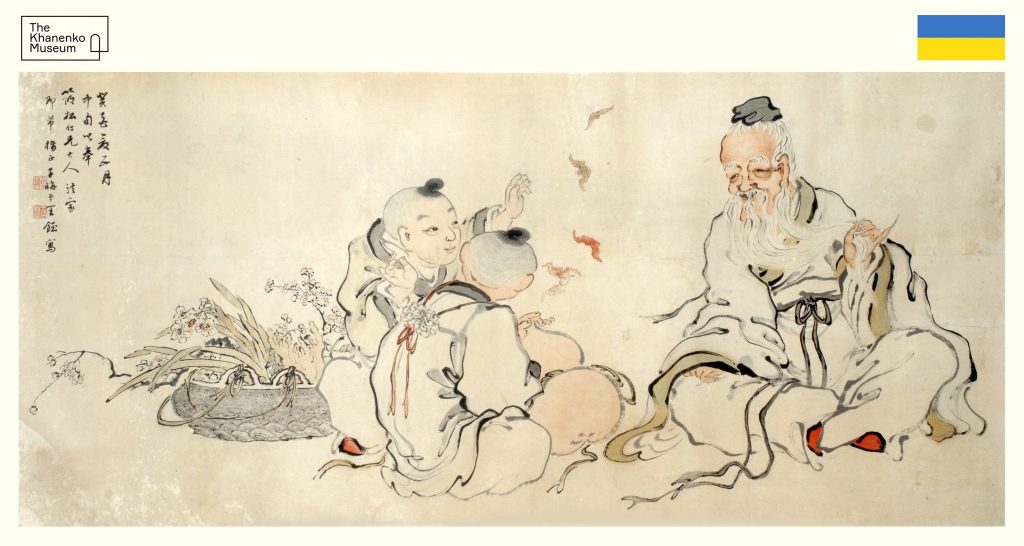
Hope you had a wonderful Slow Art Day and wherever you are, you think about our colleagues in Kyiv.
Those of us who love art – and love helping more people learn to look at and love art – we form a global city, and this year one of our neighborhoods is under attack.
Yet, our neighbors still found a way to celebrate Slow Art Day.
They inspire us and have shown us all how to live even in the most difficult moments.
And for that and many other reasons, they deserve *all* of our support and attention.
Phyl
P.S. Here’s the Word file with their prompts and comments.
Happy Slow Art Day 2022
Slow Art Day 2022 is happening now all over the world in more than 175 museums, galleries, hospitals, sculpture parks, and other settings.
Plus, many more people are simply finding ways to slow down today.
Check out Instagram for #slowartday to see photos and videos of what’s happening.
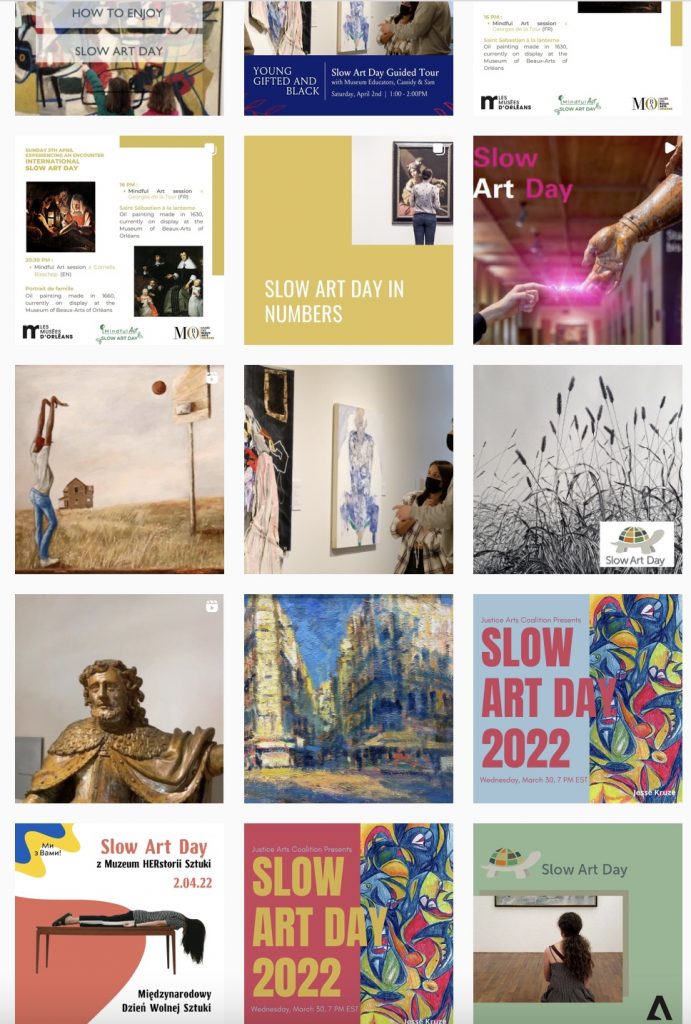
I founded Slow Art Day as an antidote to the screen-based fast-paced multi-tasking world we were all creating back in the 2000s (Apple and Facebook were both clients when I first came up with the idea).
If you are an educator, curator, or artist leading slow looking sessions today, then know you are part of a global movement – that as you guide your visitors to slow down, so are many of your peers simultaneously doing the same thing all over the world.
And please take pictures and video. Post with the hashtag #slowartday. And send us your report.
Otherwise, whoever you are, go look at art slowly today.
Visit a museum or gallery. Or go online with longtime Slow Art Day leader, the National Museum of Women in the Arts.
Look at 5 works for 10 or more minutes each (the courageous might choose one work and look for an hour).
Meditate.
Breathe.
Shift positions. Look away and then look back.
Be open to the profound love you may experience when you slow down and really look at art.
Certainly allow yourself to see beyond what you *expect* to see.
Most of all, have a happy and slow day.
Love,
Phyl
Happy Slow Art Day Eve!
Happy Slow Art Day Eve 2022.
174 museums, galleries, hospitals, sculpture parks and other venues are hosting slow looking sessions all over the world – from South Africa to Slovenia, Singapore to Serra Negra, Melbourne to Manhattan, Oaxaca to Orléans, Verona to Vilnius, and many, many other places.
Check out the Instagram tag, #slowartday to see what these educators, curators, artists, and art-lovers are doing around the world.
And, most of all, have a happy and *slow* day of looking at and loving art.
Phyl and the Slow Art Day team
6 Days to Slow Art Day
Six days and counting to Slow Art Day 2022 – Saturday, April 2.
More than 170 galleries, museums, hospitals, and other venues are hosting a celebration of slow looking.
But some may ask: why slow art amidst war?
We have no high-falutin promises to make about the power of art, nor any particular insights about war and how to stop it.
We don’t even know how to use words to describe the terrible wars raging in Ukraine and other parts of the world (remember: there have been ongoing wars in Africa and the Middle East for decades now).
We can, however, point you to some art.
Start with The Financial Times and their survey of four contemporary Ukrainian artists, The Ukrainian artists making work as acts of resistance (article available free), which features Kinder Album (see below), Maria Kulikovska, Nikita Kadan, and Vlada Ralko.
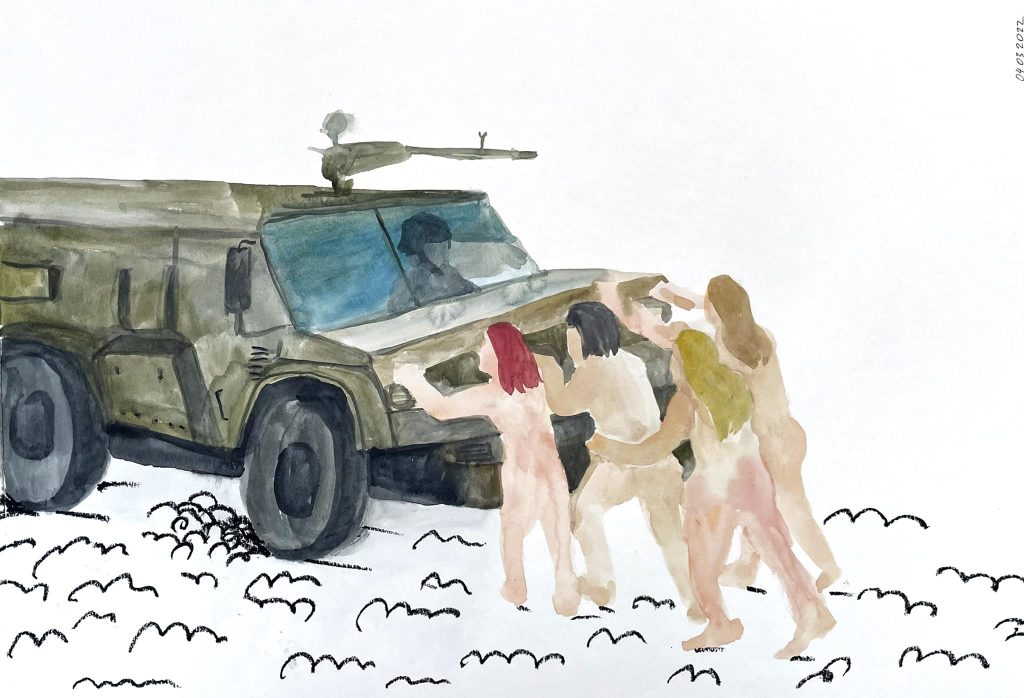
And the one thing we can say is this: Make (and look slowly at) art, not war this Saturday, April 2.
– Phyl and the Slow Art Day team
P.S. If you are hosting Slow Art Day at your museum, gallery, hospital, or other venue, be sure to read our 2021 Annual Report for inspiration and suggestions for designing your slow looking sessions.
Eight Days Until Slow Art Day 2022
With Slow Art Day 2022 just more than a week away, I’m happy to say that the trend of citywide Slow Art Day celebrations continues.
In addition to Bloomington, Illinois and it’s *9* galleries coming together for Slow Art Day, Antwerp, Belgium has *8* museums, galleries and other venues hosting slow looking events this Saturday, April 2.
Meanwhile, London, England has *4* and Naples, Florida has *3* (see this list of venues for all the global sites).
Will we see more such citywide celebrations in future years?
I hope so.
I’m also excited to say that this year for Slow Art Day more than 170 total museums and galleries have registered with us. We know even more events are happening. (Note: If you are hosting a celebration of Slow Art Day and have not registered, then please do so here.)
Eight days left until the world comes together yet again for our annual celebration of the art of looking at and loving art.
Phyl and the Slow Art Day team
P.S. Don’t forget to consult our 2021 Annual Report for ideas on how to design your Slow Art Day sessions this year.
First Citywide Slow Art Day Planned
A group of nine galleries in Bloomington, Illinois is banding together to celebrate the first citywide Slow Art Day planned anywhere in the world.
In 2020 during the pandemic, Pamala Eaton, owner and gallerist of Eaton Gallery in Bloomington, Illinois, was both the first in Bloomington to celebrate Slow Art Day and the first in the world to do so with a ‘drive-by’ window display (done because of the pandemic). With the pandemic still raging in 2021, Eaton hosted another drive-by.
This year, however, she organized eight other galleries to join her in *another* first – a citywide celebration of Slow Art Day in this community that is an important link in the historic U.S. Route 66.
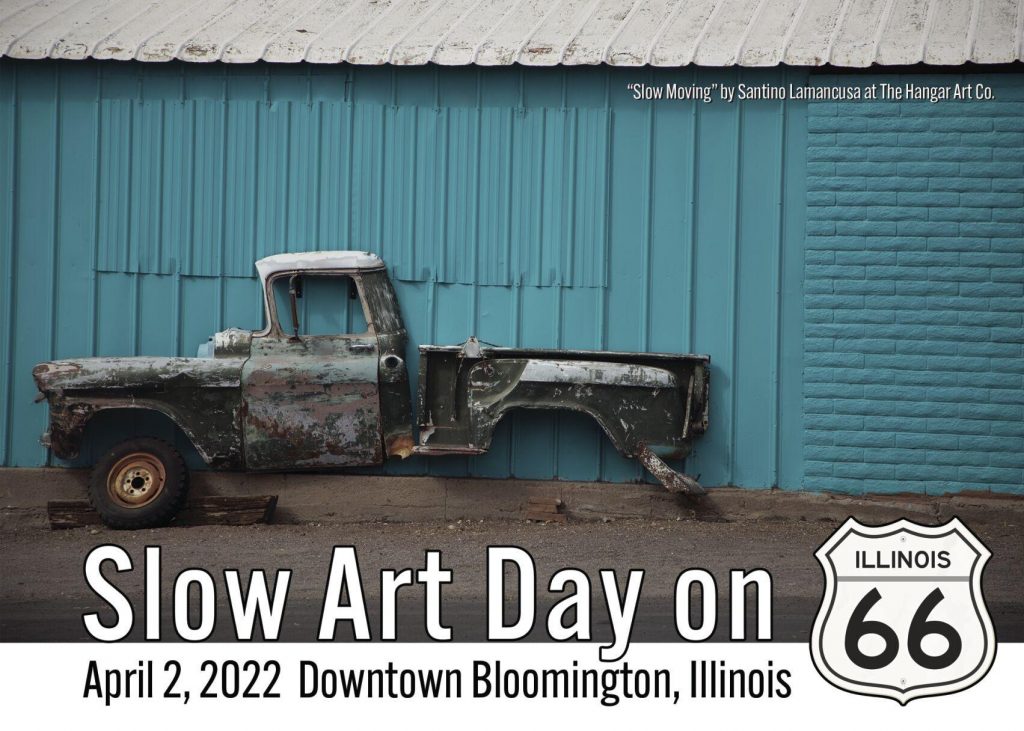
See the map of all the galleries and read more about their citywide plans in this article in Bloomington’s newspaper, The Pantagraph.
We hope this inaugural citywide Slow Art Day event is just the first of many citywide celebrations to come.
Best,
Phyl
P.S. If you get some good press, or are doing something innovative with your Slow Art Day 2022 and would like to share it in advance with the global community, then please get in touch.

